The path leads through a deep, remote forest, far away from the main road. The forest resembles a jungle; the trees stand close together, and the ground is covered with a thick carpet of creeping plants. The road narrows into a rugged path, jolting and hopping as it winds its way.

Slowly, it descends toward the Mississippi River before leading downhill into Rodney - an almost completely abandoned place with a rich history. Here, among a few still-inhabited farms and many more abandoned homesteads whose residents left long ago, stands the Rodney Presbyterian Church - a historic church in Alcorn, Mississippi, reputed to be a "ghost church."

Lost Place and Ghost Town
The church itself is not to blame for this eerie reputation. It is more the haunting atmosphere of the "Lost Place" Rodney that evokes a sense of ghostly desolation. Despite the glowing sun overhead, the town—once bustling with life and activity - is now empty and silent, like a ghost town. What was once a thriving community has become an abandoned relic of history.

The humid air feels heavy, saturated with memories of times long past. Today, much of the area is frequently flooded; some of the newer settlers who sought refuge here from modern civilization have taken precautions by building their homes on stilts.

The Rodney Presbyterian Church - a brick jewel that silently holds countless stories - stands at ground level on a small hill.

For nearly 200 years, this church has endured. In 1828, the Mississippi legislature granted permission to a sub-congregation of the Bethel Church in Rodney, Jefferson County, MS, to build its own place of worship.

Planning began in 1829, and just three years later, in 1832, the church was dedicated. Even in its long-abandoned state today, the ruin retains its beauty: a Federal-style structure made of red brick with rounded arcades, a stepped gable, and a striking octagonal bell tower.

A Place of Prosperity and Decline
When the church was newly built, Rodney was a thriving hub full of life. Trade along the Mississippi River and agriculture brought prosperity to the community. David Hunt, known as "King David," was wealthy enough to donate land for the church. The church stood as a symbol of this prosperity - proudly towering above the surrounding pines. At that time, one could even see the Mississippi River from its grounds; today, however, the river has retreated several kilometers away.

But Rodney's golden age was short-lived. The town suffered repeated flooding that drastically altered life there on multiple occasions. Yet natural disasters were not the only forces shaping Rodney's destiny.

The Raid of the Church
During the American Civil War, the church became the site of an extraordinary event: On September 13, 1863, during a Sunday service led by Reverend Baker, Union soldiers from a ship anchored along the river were invited to attend worship. This act was usually tolerated by Confederate forces since they themselves respected Sunday services as sacred.

The USS Rattler, patrolling below Natchez on the Mississippi River to intercept Confederate crossings and inspect riverboats while escorting supply ships, was part of these events. On that fateful day in September 1863, Union soldiers attending church were captured by Confederate guerrillas.
To Storm the Church
This time, however, events took an unusual turn. A junior Confederate commander decided to take action. That Sunday morning, he ordered his men to storm the church and take 16 crew members - including Captain E.H. Fentress of the Rattler - hostage during their service.

When word reached the rest of Rattler's crew about this violation of Sunday peace by Confederate forces, they responded by firing a cannonball at the church’s front wall. The impact left behind a scar—a gaping hole—that remains visible to this day.

The warning shot proved effective; it forced negotiations that led to the release of both soldiers and sailors.
Ghostly Silence
Today, several memorial plaques commemorate this near-tragedy; yet only rarely do curious visitors venture down this remote path to explore Rodney's "Lost Place." The church itself—listed on the National Register of Historic Places since 1973 - stands as both a monument to transience and a testament to decay. By 1923, only 16 members remained in its congregation; they could no longer afford to pay their pastor. Thus began Rodney's gradual exodus.

Over time, ownership of the church changed hands several times. Although it was renovated at points in its history, relentless weathering took its toll on both structure and spirit. Services continued sporadically under guest pastors and elders until financial constraints forced its sale in the 1960s. For nearly six decades after that sale, it stood empty - its walls crumbling into disrepair.
A New Beginning?

Recently, however, there has been hope for this historic site: The Rodney History & Preservation Society acquired ownership of the church with an ambitious mission - to save it from complete ruin. This effort will not come cheaply; beyond cosmetic repairs, urgent structural reinforcements are needed to prevent further collapse.

Listed on the National Register of Historic Places since 1973 as an important cultural landmark, this memorial to impermanence relies heavily on donations for its preservation efforts. The Rodney History & Preservation Society—a group of passionate history enthusiasts - is actively raising funds to halt its decline and protect this valuable legacy for future generations.

The church remains open to visitors today and is just as impressive inside as it is from afar. Anyone wishing to contribute toward its preservation can send donations via check:
RODNEY HISTORY & PRESERVATION SOCIETY
PO BOX 312 LORMAN, MS 39096













